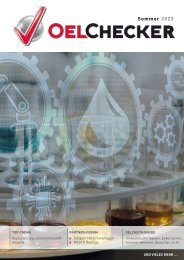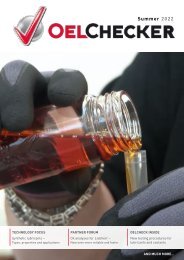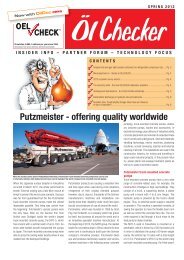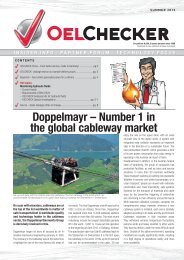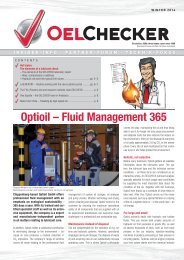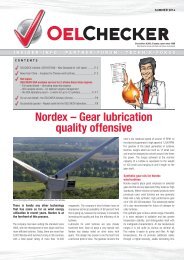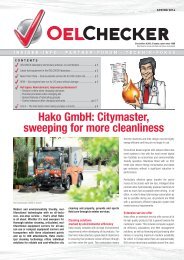OELCHECKER - Winter 2012
> OELCHECK China – Getting ready before the new laboratory opens > OELCHECK Laboratory – quicker and more accurate with a new particle counter > Hot Topics: The analysis of lubricating greases > Correct sampling > Most important analysis methods > Experience of our experienced tribologists > In demand – optimising online documentation of laboratory reports > and much more...
> OELCHECK China – Getting ready before the new laboratory opens
> OELCHECK Laboratory – quicker and more accurate with a new particle counter
> Hot Topics: The analysis of lubricating greases
> Correct sampling
> Most important analysis methods
> Experience of our experienced tribologists
> In demand – optimising online documentation of laboratory reports
> and much more...
You also want an ePaper? Increase the reach of your titles
YUMPU automatically turns print PDFs into web optimized ePapers that Google loves.
Bleeding test Penetration Sulphate ash<br />
Shearing burden<br />
Bleeding test information<br />
• If the values are between 5 and 25% and the<br />
difference between the used and fresh grease<br />
is +/- 15% or less, the grease can still be used<br />
without changing the re-lubrication intervals.<br />
• If the used grease loses considerably more oil<br />
than the fresh oil, the thickener is no longer<br />
able to maintain the base oil in its sponge-like<br />
structure.<br />
• If considerably less oil is released from the used<br />
grease, it has already begun to dry out. The<br />
bearing surface is „hungry“ for lubrication. It<br />
must be lubricated again.<br />
• Residual oil content levels which are too low may<br />
be caused by the following:<br />
- too much usage time and lack of or insufficient<br />
re-lubrication<br />
- strong vibrations, load or rotation speeds<br />
- mixing of greases which have been saponified<br />
differently<br />
- impurities caused by water, acids or lyes<br />
- insufficient temperature resistance<br />
- oxidation and ageing (acetifying) of the base oil<br />
Penetration – consistency<br />
While viscosity describes the ability of a lubricating<br />
oil or a hydraulic fluid to flow, consistency refers to<br />
the extent to which a lubricating oil is stiff. However,<br />
the consistency of a grease is not directly linked to<br />
the viscosity of its base oil or the kind of thickener<br />
used. The National Lubricating Grease Institute<br />
(NLGI) in the USA divides lubricating greases into<br />
classification groups based on their consistency.<br />
Penetration<br />
number<br />
Consistency at room<br />
temperature<br />
000 445–475 Very liquid<br />
00 400–430 Liquid<br />
0 355–385 Semi-liquid<br />
1 310–340 Very soft<br />
2 265–295 Soft<br />
3 220–250 Semi-solid<br />
4 175–205 Solid<br />
5 130–160 Very solid<br />
6 85–115 Extremely solid<br />
Alongside the variety and viscosity of the base<br />
oil, the consistency category it belongs to is another<br />
important value to classify the firmness of the<br />
grease. The consistency shows whether the grease<br />
is feedable or whether it has become too firm, e.g.<br />
as a result of bleeding.<br />
The consistency is measured using a standardised<br />
cone. The grease is spread into a small pot.<br />
The tip of the cone touches the grease. The penetration<br />
depth is reached in 5 seconds, measured<br />
in 0.1 mms and produces the grease penetration<br />
number used to determine the NLGI class. The<br />
softer the grease, the deeper the cone penetrates.<br />
This indicates a high penetration number and a low<br />
NLGI class.<br />
NLGI classes<br />
Information about grease penetration<br />
The comparison of fresh and used grease penetration<br />
allows certain conclusions to be drawn:<br />
If the used grease has become softer and therefore<br />
has a higher penetration number than fresh grease:<br />
• a grease may have mixed with another grease.<br />
In particular, greases with different thickener<br />
types become softer when they are mixed.<br />
• If a grease has been contaminated by water<br />
or another liquid.<br />
• If the grease has been mechanically sheared and<br />
loaded (tapered roller bearing).<br />
A strong drop in the penetration number, which<br />
causes a lower penetration depth of the measuring<br />
cone, indicates that:<br />
• The grease may have been bled by excessively<br />
strong vibrations.<br />
• Too high temperatures may have resulted in oil<br />
separation.<br />
• High levels of pressure in the central lubrication<br />
system have disturbed the balance between<br />
base oil and thickener.<br />
Sulphate ash –<br />
wear and impurities<br />
Investigating sulphate ash is a process used to<br />
determine inorganic (firm) levels in organic samples.<br />
This is determined by heating the sample to<br />
temperatures of 775 °C. At this temperature the<br />
organic elements in the samples „combust“ (e.g.<br />
the oil). All that remains are ashes, which consist of<br />
metallic oxides (soap, additives) and impurities. By<br />
smoking this with concentrated sulphuric acid, the<br />
oxides in the ashes are transformed into sulphates.<br />
The weight of the remains is then recorded.<br />
Information about sulphate ash<br />
• If the proportion of sulphate ashes in the used<br />
grease has increased compared to the fresh<br />
grease, this is a clear indication of impurities<br />
and/or wear.<br />
• If the metal values determined by the AES process<br />
are also consulted at this stage, the cause<br />
of the weight increase can be clarified. High<br />
levels of iron and chromium point to wear, while<br />
increased proportions of silicon and calcium hint<br />
at impurities.<br />
• The weight of the sulphate ash is affected by:<br />
- metallic abrasion from bearing wear<br />
- hard impurities such as silicon (dust), which<br />
often indicates that too much time has passed<br />
between re-lubrication intervals<br />
- levels of solid lubricants such as MoS 2<br />
- metal organic EP additives<br />
- other metal soaps and inorganic thickeners,<br />
recorded with another grease they have been<br />
mixed with<br />
Shear stress, visible viscosity –<br />
rotation speed suitability<br />
A rheometer is used to measure the visible viscosity<br />
of a grease at different temperatures. For this<br />
purpose a small amount of grease is placed on<br />
a temperature-controlled plate. The plate-based<br />
testing cone, which develops a gap between the<br />
upper and the lower plates, moves on to the film<br />
of grease. The force between the plates and the<br />
cone is measured as dynamic viscosity, which for<br />
grease is also called „shear viscosity“. The stability<br />
after the shearing, which, for instance, assesses<br />
characteristics such as deformability of a lubricating<br />
grease, can be described in apparent viscosity<br />
terms. The rheometer gives the shear viscosity at<br />
the beginning and the end of the testing procedure<br />
and displays the shear viscosity decrease in<br />
percentage terms.<br />
Information about apparent viscosity<br />
Using the index, particularly when compared with<br />
different fresh greases or through trend analyses,<br />
the following can be determined:<br />
• whether the grease is suitable for high rotation<br />
speeds.<br />
• the lower temperature limit at which the grease<br />
can be used.<br />
• whether the grease is suitable for specific types<br />
of bearing (spherical roller bearings).<br />
Dropping point – temperature resistance<br />
As temperatures rise, lubricating greases behave<br />
differently to edible fats. They do not melt like butter<br />
or coconut oil when warmed. Lubricating greases<br />
hardly change at all as the temperature rises<br />
because the thickener holds the base oil firm.<br />
Only when the thickener‘s critical temperature has<br />
been reached does the soap structure dissolve.<br />
To determine the dropping point, a grease sample<br />
is warmed in the testing device until liquid drops<br />
fall through the opening of a nipple to the bottom<br />
of the test tube. Gel or powder-based lubricant<br />
greases which are measured at temperatures of over<br />
300 °C are considered as not having a dropping point.<br />
Information about dropping points<br />
There is not always a correlation between a<br />
grease‘s dropping point and its maximum operating<br />
temperature. Of course, the permissible temperature<br />
is always less than the dropping point value.<br />
Not just the thickener, but most of all the type of oil<br />
are what determine a grease‘s maximum operating<br />
temperature.<br />
A lower dropping point of a used grease in comparison<br />
to a fresh grease may be caused by the<br />
following:<br />
6




